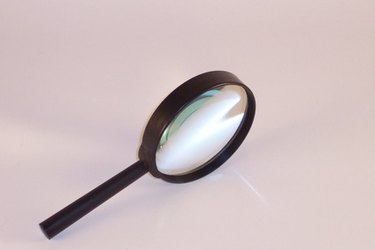
Men have carved or engraved bone, teeth and ivory since ancient times. Scrimshaw, however, usually refers to the American art of carving or engraving whale teeth or bones. Modern scrimshanders (those that carve or engrave scrimshaw) have necessarily expanded to include horn, ancient ivory and even plastics. Consequently, determining the value of scrimshaw or other carved items can be difficult.
Describing your Piece
Video of the Day
Step 1
Examine the piece with a magnifying glass. Plastic items will be smooth. Natural materials such as ivory and horn have a grain.
Video of the Day
Step 2
Consider the color and condition of the piece. Ivory turns yellow with age. Additionally, uncared-for ivory may develop cracks and other defects due to age.
Step 3
Write out the item's history as you understand it. The age and origin of the piece will aid your later comparisons.
Step 4
List the defining features of the piece such as its size, shape, any remaining natural features and the subjects of the carving or engraving. Whaling scenes are the most commonly collected, but other nautical, home and patriotic scenes are also valuable.
Step 5
Examine any signatures, artist marks or dates. Not all scrimshaw have these additions, but the most valuable pieces are engraved with one or all. These marks will also aid identification of the piece.
Comparisons
Step 1
Search public auction web sites for like pieces. This is the easiest way to gather additional information about your pieces. You can search for multiple known factors such as age, origin, material, scene and/or artist. A systematic search could begin by searching with as many keywords as possible and then slowly expanding the results by removing key words. A search for "scrimshaw whaling scene" will return more results than "1821 scrimshaw whaling scene."
Step 2
Buy a book about scrimshaw. This is a good second step if you have multiple, and possibly valuable, scrimshaw.
Step 3
Consult an expert in American art if the piece's provenance or the previous search results lead you to believe your scrimshaw is valuable; was made of whale ivory; or from before 1910. If you plan to sell the piece, an art auction house will necessarily authenticate your scrimshaw. Many large American cities also have art appraisers that can authenticate scrimshaw for a fee. Conversely, a local art museum or university art department might be willing to examine your heirloom scrimshaw for free.
Tip
Some collectors consider scrimshaw to only include pieces made of whale ivory carved by American or European whalers during the nineteenth century. Consequently, these pieces are most valuable.
Nineteenth-century carvings or engravings of whale ivory made by other cultures, including Japanese and Inuit whalers, are still valuable, even if they may or may not be considered scrimshaw.
Modern carvings and engravings made from plastic or other materials and possibly with multiple colors, may still be valuable art pieces in their own right.
Warning
It is not advised to test the heat absorption of plastic, ivory or other materials. You will damage a potentially valuable scrimshaw or carving. This includes the heated needle method commonly prescribed on the internet.
Check multiple sources before selling any art piece, including scrimshaw.